NCERT Revision Notes for Chapter 4 Animal Kingdom Class 11 Biology
CBSE NCERT Revision Notes1
Answer
Animal kingdom shows a great diversity of life in comparison with the plant kingdom.
All animals are metazoans (multicellular, eukaryotic, and heterotrophic animals).
Basis of Classification:
Classification is based on their features like
- Arrangement of cells
- Level of body organisation
- Body symmetry
- Nature of coelom
- Patterns of digestive, circulatory or reproductive systems.
2
Answer
It exhibits considerable variation among animals.
Following are the major types
1. Cellular level
- Cells are arranged as loose cell aggregates.
- It shows no co-ordination to form tissues.
- Individual cells are capable of performing specific functions.
- Example: sponges
2. Tissue level
- Cells performing similar function are aggregated to form tissues.
- Example: Coelenterates (hydra)
3. Organ level
- Tissues are grouped together to form organs.
- Each organ is assigned to execute specific function.
- Example: Platyhelminthes and other higher phyla
4. Organ system level
- A group of organs working together as a larger unit is called an organ system
- Organ system exists in various patterns as illustrated below
3
Answer
In animals, the mouth, tongue, teeth, salivary glands, pharynx, oesophagus, stomach, small intestine, large intestine, liver, gall bladder, bile ducts and pancreas together constitute the digestive system. It is of two types
- Incomplete: digestive system has only a single opening to the outside of the body. It acts as both anus and the mouth.
Example: Platyhelminthes and Coelenterates - Complete: The digestive system has two separate openings at each end, the mouth and the anus.
Example: Man
4
Answer
It is of two types.
- Open type: blood is pumped out of the heart, and the tissues are bathed in it.
Example: arthropods and molluscs - Closed type: Blood flows inside blood vessels of varying diameters (arteries, veins, capillaries) without coming in direct contact with body cells.
Example: in many invertebrates (cephalopods), and all vertebrates
5
Answer
Arrangement of body parts on the sides of the main median axis of the body. This idea was given by Haeckel.
Animals exhibits 3 types of symmetry
- Asymmetry: Body cannot be divided in to two equal halves through any plane passing through centre.
Example: sponges - Radial symmetry: Body can be cut into two exact halves through any plane which pass through the central axis. Such animals have two ends in the main body axis the oral and aboral end, but no left and right sides.
Example: Coelenterates, Ctenophora and Echinodermata - Bilateral symmetry: Body can be divided into two identical halves only through a single plane passing through central axis. These animals have a front and rear end. They also have an upper and lower side. They have equivalent left and right lateral sides.
Example: Annelids, Arthropods, etc.
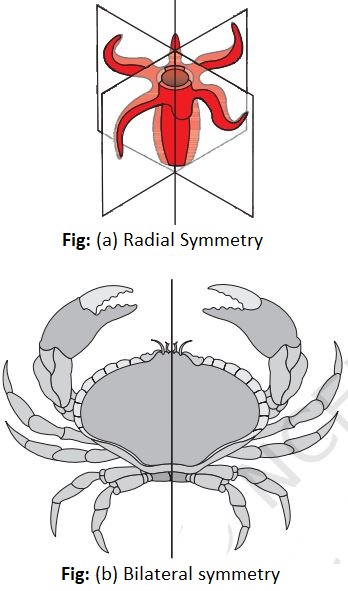
6
Answer
This classification is based on number of embryonic cell layers and divided into two:
- Diploblastic: Cells are arranged into two embryonic layers, i.e. outer ectoderm and inner endoderm and a middle undifferentiated mesoglea.
Example: Coelenterates and Sponges - Triploblastic: Three embryonic layers are present i.e. .outer ectoderm, middle mesoderm and inner endoderm. All the tissues and organs are formed from these three layers. Ectoderm give rise to epidermis and nervous system etc., mesoderm to muscles, endoskeleton, reproductive organs, coelom, etc. and endoderm to the alimentary canal, lungs, etc.
Example: Platyhelminthes
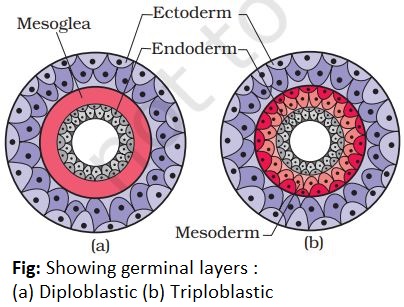
7
Answer
The fluid filled body cavity in between the body wall and the digestive tract of animals is called the coelom. The coelom is lined by mesodermal epithelium on either side. All the internal organs are suspended in the coelom.
The coelom allows greater body flexibility. It acts as a shock absorber. In soft bodied animals it protects internal organs from external shocks. In some animals it acts as an internal skeleton. Example: earthworm
Animals are divided in to 3 groups on the basis of nature of coelom.
- Acoelomates: Body cavity is absent and coelomic space is occupied by parenchyma like cells.
Example: Platyhelminthes - Pseudocoelomates: Animals having false coelom. Body cavity is not formed from the mesodermal epithelium. Mesoderm appears as scattered pouches in between ectoderm and endoderm. In these animals pseudocoelom is formed from the embryonic cavity called blastocoel.
Example: Aschelminthes - Coelomates or Eucoelomates: Animals with true body cavity.
Example: Annelids, Molluscs, Arthropods, Echinoderms, Hemichordates, and Chordates.
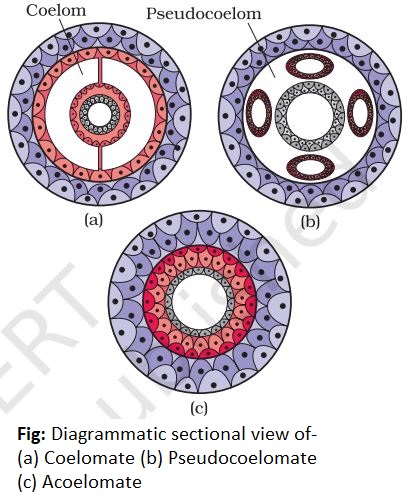
8
Answer
In some animals the entire length of body is transversely divided in to a number of ring like parts called segments. This phenomenon of segmentation is called metamerism.
This pattern is clearly seen in annelids like earthworm and arthropods like millipedes and centipedes.
In earthworms the segmentation helps in locomotion.
In arthropods the metameric segments may be paired appendages for various functions such as legs for locomotion, antennae for sensory functions and mouth for feeding etc.
In insects, these metameric segments are grouped to form body regions like head, thorax, and abdomen.
9
Answer
It is a mesodermally derived rod like structure present dorsally during embryonic development
It is a stiff and flexible rod of tissue running along the dorsal side below the nerve cord and above the alimentary canal.
Based on the presence or absence of notochord, animals are classified in to 2 groups
- Chordates: Animals with notochord. In chordates, the notochord is present at some stage in their life.
Example: fishes, birds, mammals, etc. - Non-chordates: Animals without notochord.
Example: Porifera to Echinoderms.
They do not possess the notochord at any stage of their life.
10
Answer
The animal kingdom includes about 3 phyla, of which 11 are considered as major phyla and others are categorised as minor phyla. Almost 99% of animals are invertebrates.
Based on common fundamental features, the kingdom Animalia is broadly classified into 11 phyla.
- Porifera
- Coelenterata
- Ctenophora
- Platyhelminthes
- Aschelminthes
- Annelida
- Arthropoda
- Mollusca
- Echinodermata
- Hemichordata
- Chordata
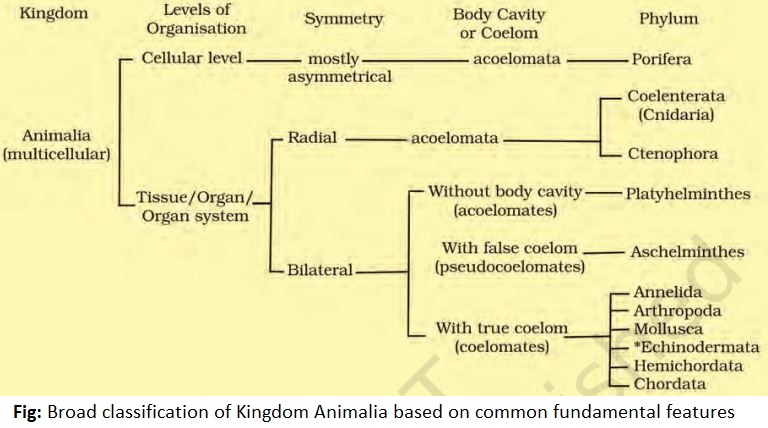
11
Answer
(porus-opening; fere-to bear)
It is the group of the most primitive animals popularly called sponges. These were recognised as animals by ELLIS. The term porifera was introduced by Robert Grant. The study of sponges called Parazoology.
Most of them are marine and remain attached to rocks. Some lives in fresh water.
Spongilla is a freshwater sponge.
Important characteristic features:
- They are sedentary in habitat and are solitary or colonial. They possess a cellular level of organisation. Cells aggregate to form body plan.
- Most of them are asymmetrical animals while some are radially symmetrical.
- They are pore bearing animals and their body is perforated by numerous openings or pores called Osta.
• Body wall: Have two loosely differentiated layers of cells. An outer dermal layer of flat cells called pinacocytes and an inner layer of flagellated cells called as collar cells or choanocytes. They are diploblastic.
• Water transport system(water canal system): Body is in the form of a cylinder which encloses a large cavity called spongocoel. Spongocoel opens out by a narrow opening called osculum. This pathway helps them in food gathering, respiratory exchange, and removal of waste.
Ostia or pores (water enters) → spongocoel (central cavity) → osculum or pores (water goes out).
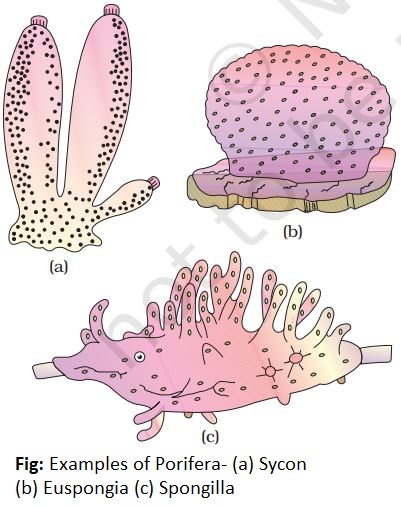
12
Answer
Each ostium leads to a canal which leads to spongocoel. The canal is lined with flagellated collar cells called choanocytes. It brings food and oxygen and carries away excretory and reproductive products.
Each choanocyte has long flagellum projecting from the free end of each cell. The lower part of the flagellum is surrounded by a transparent collar. In simple sponges the canal is not well developed. In such cases the ostia open in to the spongocoel through hollow cells called porocytes and the spongocoel is lined with choanocytes.
• In between the two layers of the body there is a non-living gelatinous matrix called mesenchyme. The mesenchyme has a number of amoeboid cells, spicules, and sponging fibres.
- Amoeboid cells: wander through the matrix carrying food between the cells.
- Spicules: are siliceous or calcareous structures formed of silica or calcium carbonate.
- Sponging fibres: are silk elastic structures.
- Skeleton: it is made up of spicules and sponging fibres.
• Sponges are holozoic (take solid food) in nutrition. The digestion is intracellular.
• Reproductive system: they are hermaphrodites (sexes are not separate) Reproduces both sexually and asexually.
Asexual reproduction takes place by fragmentation and budding. Fresh water sponges during unfavourable conditions produce buds known as gemmules which remain dormant till favourable season.
During Sexual reproduction, some amoeboid cells become Exampleg or sperm. Fertilisation is internal and the development of larva is indirect. After fertilisation the zygote develops in to a larva. The larva of sponges are ciliated and free swimming.
They are of 2 types: amphiblastula and parenchymula.
• All sponges possess great power of regeneration.
• Examples for common sponges are Leucosolenia, Spongilla (fresh water sponge), Sycon (scypha), Euspongia (bath sponge), Eupelectella (venus flower basket).Its dried skeleton is used as a costly marriage gift in japan. It is considered a symbol of union till death. Hyalonema (glass rope sponge), Cliona (sulphur sponge), Chalina (dead man finger sponge), Proterion (neptunes cup) are some more examples.
Classification of Porifera
- Class I: Calcarea (calcareous sponges. Example: Sypha, Leucosolenia, etc.)
- ClassII: Demospongia (skeleton of sponging fibres. Largest class of sponges. Example: Euspongia, Spongilla, etc.
- ClassIII: Hexactinellida (glass sponges with silicious spicules. Example: Euplectella, Hyalonema, etc.
13
Answer
Animals belonging to the phylum coelenterata are commonly called coelenterates or Cnidarians. They are more advanced than sponges in having true tissues. It includes about 9000 species. They are aquatic. Most of them are marine. Hydra is a fresh water form.
Important characteristic features:
- They are sessile or free swimming.
- They exhibit a tissue level of organisation.
- Acoelomates
- Radially symmetrical. But sea anemone is biradially symmetrical.
• Body wall: Diploblastic (outer ectoderm, inner endoderm and middle mesoglea)
• Body cavity: A central gastro vascular cavity or coelenteron which opens out through mouth or hypostome. Anus is absent. Body cavity does both digestion and circulation of food.
Coelenterates are holozoic and carnivorous in nutrition.
• Digestion: it is intracellular and extracellular. Mouth is surrounded by many finger like structures called tentacles. It is used for food capture and defence.
• Cnidoblasts: Certain ectodermal cells are modified into stinging cells or cnidodoblasts or cnidocytes, hence the name Cnidaria. Each cnidoblast possesses a stinging capsule called nematocyst containing poisonous fluid.
Cnidoblasts are defensive cells used to kill or paralyse other prey and enemies. They are mainly found on the tentacles.
The nematocyst poison of Physalia is a neurotoxin
• Phylum includes two distinct types of individual.
- Polyp: sedentary, with a tubular body and mouth surrounded by circlet of tentacles. It represents the asexual stage. Example: Hydra and Adamsia.
- Medusa: free floating with a soft, transparent bell like body with tentacles at the margin.
• It is Umbrella like.
• Mouth at the centre of concave surface which is directed downward.
• It represents the sexual stage.
• Medusa can be regarded as an upside down polyp. Example: Aurelia
• In hydra medusa stage is absent. It reproduces sexually in the polyp stage.
• Reproduction: asexually and sexually.
• Asexual reproduction: It takes place by budding in polyp and gives rise to medusa.
• During sexual reproduction, medusa liberates gametes into water. After fertilisation; the zygote develops into a larva. Larvae of cnidarians are ciliated and free swimming. They are called planula. The planula grows into sessile polyp.
• Coelenterates exhibit alternation of generation in their life cycle. In coelenterates which exist in both forms (polyp and medusa), the asexual polyp generation alternates with sexual medusa generation. Example: Obelia
• Polymorphism: many colonial cnidarians exhibit this phenomenon where the individuals (zooids) of the colony show morphological and functional differentiation. Example: Halistemma, Physalia etc.
• Examples of common coelenterates are Hydra, Obelia (sea fur), Aurelia (jelly fish), Physalia (potuguese man of war), Adamsia (sea anemone), Vallela (sail by wind), Fungia (mushroom coral), Astraea (star coral), Pennatula (sea pen), Gorgonian (sea fan), Madrepora (stag horn coral), Meandrina (brain coral), Corallium (red coral), Porpita.
Classification of coelenterata
- Class I: Hydrozoa (both polyp and medusa form occur. Example: Hydraobelia, Physalia, etc)
- Class II: Scyphozoa (only medusa form occurs. Example: Aurelia)
- Class III: Anthozoa (only polyp form occurs. Example: Adamsia, Fungia, Astraea, Pennatula, Gorgonia, Madrepora, Meandrina, Corallium, etc.
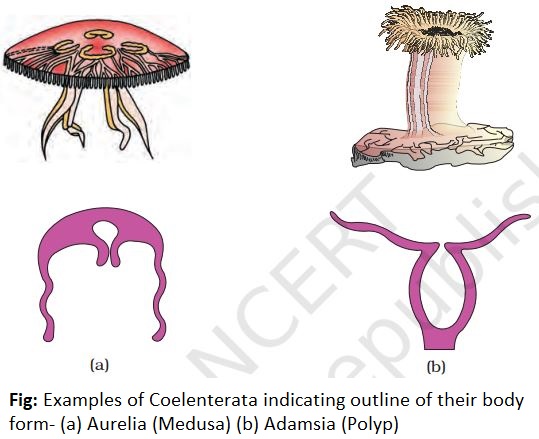
14
(Ktene-comb; phors-bearing)
Answer
This phylum was first recognized by Eschololz in 1928. It includes only small group of animals (50 species). The animals belonging to the phylum are commonly called sea walnuts or comb jellies.
Important characteristic features:
- They are free swimming or pelagic.
- They are marine animals.
- Body is soft gelatinous and transparent.
- They are acoelomates and have the property of bioluminescence.
Symmetry: They are radially symmetrical (arrangement of comb plates gives the appearance of radial symmetry) but the tentacles and branching of gastro vascular cavities show bilateral symmetry. So some zoologist explain it is as biradial symmetry
Diploblastic organism and exhibit tissue level of organization.
Comb plates: animal body bears 8 external rows of cilia. Cilia in each row join together to form comb plates. The ciliary movements of comb plates help in locomotion.
Tentacles: a pair of long, retractile tentacles arise from blind pouches in opposite sides of the body, tentacles bear colloblast or collocytes which help in food capture.
Digestion: it is both extracellular and intracellular.
Statocyst: a peculiar sense organ seen in opposite end of the mouth. It helps in equilibrium.
Reproduction: sexually only. They are hermaphrodites. Fertilization is external. Development include Cydipid larva.
Common ctenophores are Pleurobrachia (sea-gooseberry), Ctenoplana, Cestum (venus girdle), Hormiphora, Beroe.
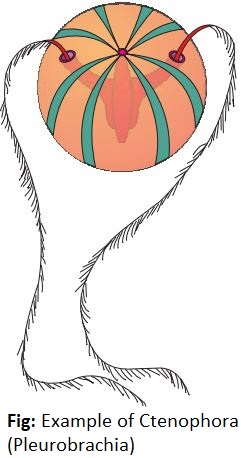
15
4. Phylum Platyhelminthes
(Platys- flat; helmins- worms)
Answer
Platyhelminthes was introduced by Gegenbaur. They are commonly called as flatworms. There are about 13,000 species of flatworms known today. Shape of the body is generally dorsi-ventrally flat, Hence the name flatworm. This is the first group of animals in which anterior part is developed into a head.
Important characteristic features:
- First group of animals to have an organ system level of organization.
- Parasitic adaptations: Presence of hooks and suckers.
- Bilaterally symmetrical with dorsal and ventral surfaces. First group of animals that show bilateral symmetry.
• Triploblastic animals: It is the first group of animals to possess 3 germ layers.
• Acoelomate animals: The space between the body cavity and alimentary canal is filled with loose parenchyma cells (mesenchyma cells) originated from mesoderm.
• Alimentary canal: It is branched. It opens out by a single opening called mouth. Anus is absent. In parasitic flat worms, alimentary canal is absent. They absorb nutrients through their body wall while living in the host intestine.
• Excretory system: it consists of branching tubes which end in specialized cells called flame cells (protonephridia). The functions of these cells are osmoregulation and excretion.
• Reproduction: Most of them are hermaphrodites. They reproduce asexually and sexually. Asexual reproduction takes place by fragmentation and regeneration. Some members possess high regeneration capacity.
• Fertilisation: It takes place inside the body and development involves larval stages (amphiblastula and parenchymula).
• The common examples for flat worms are Tapeworm (Taenia or pork tape worm), Liver fluke (Fasciola), and Blood fluke (Schistosoma), Planaria, Echinococcus (Dog tape worm).
Classificationof Platyhelminthes
- Class I: Turbellaria (free living flatworms, Example: Planaria)
- Class II: Trematoda (ecto or endoparasites with oral and ventral suckers, Example: liver fluke, blood fluke, etc).
- Class III: Cestoda (exclusively endoparasites with scolex, Example: Taenia solium (pork tapeworm), Taenia saginata (beef tapeworm), etc).
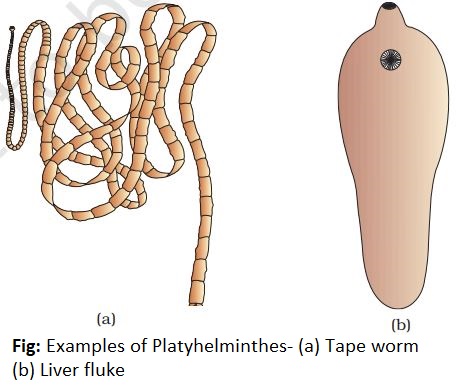
16
Answer
Animals belonging to this phylum are commonly called roundworms or thread worms or bagworms or nematodes. It includes about 15,000 species. Out of which about 15 species are parasites of man.
Important characteristic features:
- Aquatic or terrestrial, either free living or parasitic in plants and animals.
- Organ system level, bilaterally symmetrical, triploblastic, pseudocoelomate animals.
- Epidermis is multinucleated.
- Circulatory and respiratory system are absent. Nervous system is present.
- They show flexible body movements.
• Body wall: It is tubular tapering at both ends and is covered with a thin cuticle.
• Digestive system: They have a tubular and complete alimentary canal within their body consisting of mouth, muscular pharynx, intestine and anus. The mouth may possess teeth to cut and pierce the tissues. The muscular pharynx is well developed which helps in sucking food from the host.
• Reproduction: Dioecious, sexual dimorphism present. The male is smaller than the female. Males have copulatory spicules which help in the process of copulation.
• Fertilization: it is internal. The zygote has a thick wall to survive adverse conditions. Development is direct or indirect.
The common examples of this phylum are Parasites in human beings- Round worms, Hook worms, Filarial worms, Pinworms, Guinea worms. Other members of this phylum-Eye worm (Loaloa), Whip worm (Trichuristrichura), Trichina worm (Trichinella)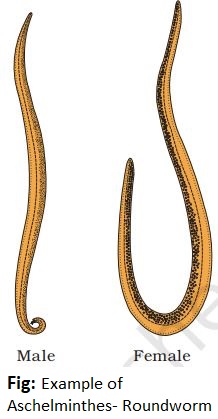
17
6. Phylum Annelida
(annulus- little ring, lidos-form)
Answer
Animals belonging to this phylum are commonly called annelids or segmented worms. The term Annelida was introduced by Lamarck in 1809. There are about 9,000 species of annelids known today. They exhibit most diverse forms ranging from 1mm to 2.5m in length.
Important characteristic features:
- They are terrestrial or marine or fresh water or parasitic.
- They possess an organ system level of body organization.
- Bilaterally symmetrical, triploblastic, true coelomates.
- Metamerically segmented: body is externally divided into segments called metameres.
- Remarkable feature of annelids is the true segmentation.
- Body surface is covered by a thick cuticle. Body wall has both longitudinal and circular muscles.
- The organs of locomotion are setae or unjointed lateral appendages called parapodia which helps swimming in aquatic annelids, Example: Nereis.
- They show skin respiration.
- They reproduce sexually. In many members a trochopore larval stage is noted.
• Digestive system: it is complete and consists of pharynx, oesophagus, stomach, intestine, etc.
• Typhlosole: A longitudinal fold present in the intestine which increase the surface for secretion and absorption.
• Chloragogen cells: Present in the cavity of typhlosole which store up food material. They synthesize glycogen and store fat. They also perform excretory function.
• Excretory system: Excretory organs are paired segmentally arranged coiled tubes called nephridia. They also help in osmoregulation.
• Circulatory system: it is closed type. Blood flows through closed blood vessel. A heart to move the oxygen carrying blood is found for the first time in the evolution of animals.
• Nervous system: It consists of a brain, segmented ganglia and a double ventral nerve cord.
• Reproduction: They are either dioecious or monoecious.
The common examples of this phylum are Earthworms (Pheretima, MExampleascolex), Nereis, Hirudinaria (blood sucking leeches), Aphrodite (sea mouse), Tubifex, Chaetopterus, Terebella.
Classification of this phylum:
- Class I: Polychaeta (numerous setae on the parapodia. Example: Nereis, Aphordite, Chaetopterus, etc.)
- Class II: Oligochaeta (setae are few, scattered over the body. Example: Earthworm)
- Class III: Hirudinea (parapodia and setae are absent. 2 suckers are present. Example: Leech)
- Class IV: Archiannelida (without setae or parapodia. Primitive annelids. Example: Polygordius, Bonelia, etc).
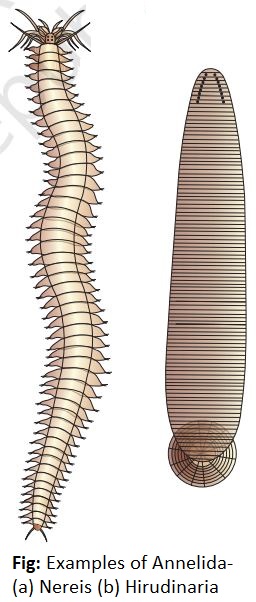
18
7. Phylum Arthropoda
(arthros- joint; poda-appendages)
Answer
They are the animals with jointed legs and appendages. Introduced by Von Siebold. It is the largest phylum in the animal kingdom. It includes 2/3 of the total named species of the animal world on earth. They are evolved about 600 million years ago. Trilobites are fossil arthropods that existed about 600 million years ago. The horse-shoe crab, an ancient relative of the Arachinds is found living in warm estuarine zones like the Sunderbans, in Bengal.
Important characteristic features.
- They are cosmopolitan in distribution. They are found in everywhere, in freshwater, in marine water, on land and in the air.
- They are joint footed animals. They possess an organ system level of body organisation.
- Bilaterally symmetrical.
- They are triploblastic animals.
- They are segmented animals.
- They are coelomates. True coelom is reduced. The body cavity is filled with blood and is called haemocoel.
- The segmented body is divided into 3 regions- head, thorax and abdomen, e.g, insects. In some cases head and thorax fuse to form a single region called cephalothorax Example: Arachinds, Crustaceans, etc.
- In some arthropods the body is divided into head and trunk only Example: myriapods.
- Cilia is absent.
- Brain is present.
- Sensory organs are well developed. Eyes may be simple or compound. Compound eye is made up of a number of independent visual units called ommatidia each with its own lens.
- Sound receptors are present in chirping crickets and cicadas.
- Heads of many arthropods have feelers called antennae for perceiving odour and sensation of touch. Insects also communicate by chemicals called pheromones.
- Arthropods are generally oviparous. Some are viviparous. In such arthropods the eggs hatch within the female and the young ones are born.
- In many arthropods the development is direct and the young ones resemble the adult.
• Exoskeleton: the whole body is covered by chitinous jointed exoskeleton. The exoskeleton is light weight, tough and composed of proteins and a polysaccharide known as chitin, resulting in a chitinous cuticle. Casting of old exoskeleton is known as moulting or ecdysis.
• Podomeres: They have jointed appendages which are differentially modified to perform different functions. Each body segment bears a pair of segmented appendages. Their segments are called podomeres.
• Reproduction: they are mostly dioecious. Fertilisation is external in aquatic arthropods and internal in land arthropods.
• Circulatory system: It is open type with a dorsal heart.
• Digestive system: It is well developed and complete. The mouth is surrounded by mouth parts which are modified into different types according to the feeding habits of different arthropods.
• Respiratory system: Respiratory organs are gills (Example: prawn) or gill books (Example: horse shoe crab) in aquatic forms, and book lungs (Example: scorpion) or tracheal system (Example: insects) in terrestrial forms.
• Excretion: Excretory organs are green glands or malphigian tubules. Nephridia are absent.
In several groups of insects the development is indirect. In such arthropods the egg hatches into an independent larva which does not resemble the adult.
The common arthropods are Araneus (garden spider), Limulus (king crab), Eupagurus (hermit crab), Cancer, Macrobrachium (prawn), Lepisma (silver fish), Periplanata (cockroach), Apis (bee), Anopheles (mosquito), Musca (housefly), Triops (tadpolefish), Daphnia (water flea), Xensopsylla (rat flea), Cyclops, Squilla, Astacus (cray fish), Barnacle (Lepas and Balanus)
Classification of phylum Arthropoda:
- Class I: barnacles, etc.)
- Class II: Myriaopoda- terrestrial, air breathing and many lExampleged (Example : millipede, centipede, etc)
- Class III: Arachnida – air breathing with 4 pairs of lExamples (Example: spider, scorpion, king crab, etc.)
- Class IV: Insecta – air breathing with 3 pairs of lExamples (Example: cockroach, butterfly, Lepisma, Oryctes, Leptocorisa, Musca, Apis silkworm, etc.) Crustacea-Mostly aquatic with gills as respiratory organ (Example: prawn, crab, hermit crab,
- Class V: Onychopora – terrestrial, air breathing with claw-bearing lExamples (Example: Peripatus, a living fossil)
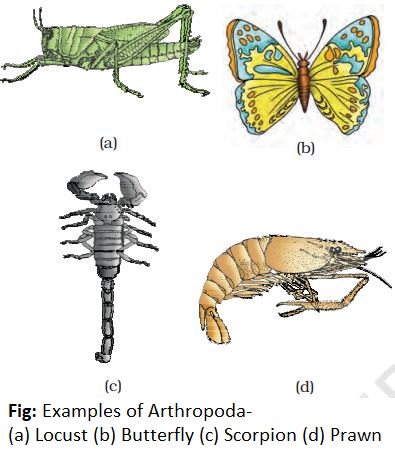
19
Answer
It is the second largest phylum of the animal kingdom. The term mollusca was proposed by Johnston. They are soft bodied and also possess a shell. The study of molluscs is called Malacology and the study of molluscans shells is called chonochology.
Important characteristic features:
- They are generally aquatic forms. Most of them are marine, some are found in fresh water, and a few are terrestrial. Grey slug is a terrestrial mollusc without a shell.
- All molluscs are soft bodied and unsegmented animals.
- They possess organ system level of body organisation.
- Bilaterally symmetrical except in univalves.
- They are triploblastic animals.
- They are true coelomates but the coelom is reduced in adults. The body cavity is a haemocoel.
- Their soft body is protected by an unsegmented external shell. The shell is made up of calcium carbonate, and is of one piece (univalve) or two pieces (bivalve). In some cases the shell is internal or absent.
- The visceral hump contains the important internal organs. It is covered by a soft and spongy layer of skin called the mantle or pallium. Mantle secretes shell. Mantle cavity has gills.
- Foot it is soft and muscular. It is the locomotory organ.
• Body consists of four parts: head, mantle, visceral hump, and foot. The head region has sensory tentacles.
• Digestive system: It is well developed, with salivary glands and liver.
• Circulatory system: Is of the open type. Heart is chambered and valvular.
• Excretion: It has Nephridia.
• Nervous system: Consists of paired ganglia connected by nerves. Sense organs are tentacles and eyes.
• Respiration: Gills (ctenidia) in aquatic forms. Pulmonary sacs in terrestrial form.
• Reproduction: Dioecious. Fertilization external or internal, mostly oviparous and a few viviparous. The larval forms are Glochidium, Trocophere and Veliger.
• The common molluscans are Pila (apple snail), Achatina (land snail), Lamellidens (mussel), Pinctada (pearl oyster), Sepia (cuttle fish), Loligo (squid) etc.
Classification:
- Class I: Polyplacophora- shell with 8 pieces. Example: Chilton
- Class II: Monoplacophora- shell with a single piece. Example: Neopilina
- Class III: Aplacophora-shell absent. Example: Neomenia
- Class IV: Scaphopoda-shell tubulr. Example: Dentalium
- Class V: Pelecypoda- shell with 2 pieces. Example: Mussel, Oyster, Teredo, etc.
- Class VI: Gastropoda- shell with one piece and spirally coiled. Example: Pila, Snail, Slug etc.
- Class VII: Cephalopoda- shell internal or reduced. Example: Loligo, Cuttle fish, Devil fish, etc.
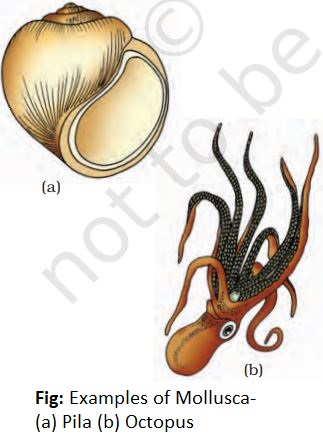
20
9. Phylum Echinodermata
(Echinos-spines; derm-skin)
Answer
They are spiny skinned or spiny bodied animals. The term echinodermata was introduced by J.Klein.
Important characteristic features of Echinodermata:
- They are exclusively marine animals.
- The body is covered by large number of spines which are generally immovable and protective in function, but in some, the spines are movable and help in locomotion. Few spines also get modified to form organs of defence known as pedicellaria. Example: Sea urchin, Star fish, etc.
- They possess an organ system level of body organisation. They are triploblastic animals.
- They are unsegmented and pentamerous, radially symmetrical in the adult, but the larval forms are bilaterally symmetrical.
- They possess an endoskeleton in the form of calcareous plates called ossicles embedded in the skin.
- They are true coelomates but a major part of the coelom has undergone a modification to form the water-vascular system which helps in locomotion, capture and transport of food, and respiration.
- Water vascular system or ambulacral system in which sea water enters through a porous plate called madreporite.
• Tube feet: The water vascular system consists of radiating canals and tube like appendages filled with water. These appendages are called tube feet (podia). Their main function is locomotion and capture of food.
• Digestive system: Complete with mouth on the ventral (lower) side and anus on the dorsal (upper side).
• Respiration: It takes place by skin gills which are protruded from the coelom over the skin.
• Circulatory system: It is reduced.
• Excretory system: It is absent. Nitrogenous wastes diffuse out through the gills.
• Nervous system: It is in the form of a central nerve ring with radial nerves extending to each arm.
• Reproduction: Sexes separate. Fertilisation external. Development is indirect through a free swimming larva.
• Echinoderms have a great power of automy and regneration.
• The common echinoderms are Asterias (star fish or sea star), Echinus (sea urchin), Echinocardium (heart urchin), Antedon (feather star or sea silly), Cucumaria (sea cucumber), Ophiura (brittle star).
Classification of Phylum Echinodermata
- Class I: Asteroidean (star shaped with 5arms. Example: star fish)
- Class II: Ophiuroidea (arms slender and flexible. Example: brittle fish)
- Class III: Echinoidea (no arms, globular body with long spines. Example: sea urchin)
- Class IV: Holothuroidea (no arms, long body with long spines. Example: sea cucumber)
- Class V: Crinoidea (arms slender and forked with branches. Example: sea lily)
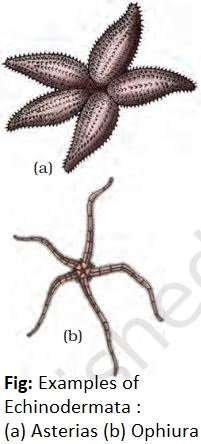
21
Answer
Have small worm-like marine animals. Was earlier placed as sub-phylum of Phylum Chordata.
Important characteristic features of Hemichordata:
- Bilaterally symmetrical, triploblastic and coelomate. Body cylindrical, has proboscis, collar and trunk. Circulation is open type.
- Respiration by gills
- Excretion by proboscis gland.
- Sexes are separate.
- External fertilization
- Indirect development.
Examples: Balanoglossus and Saccoglossus.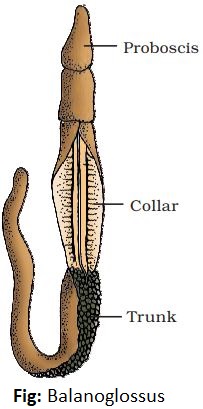
22
Answer
Presence of Notochord (between gut and nerve cord)
Have dorsal hollow nerve chord.
Have paired pharyngeal gill slits.
Heart is ventral.
Post anal tail present.
Bilaterally symmetrical, triploblastic, and coelomate with organ system level of organization.
Circulation is closed type.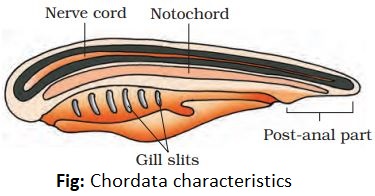
Differences between Chordata and Non-chordata
Phylum Chordata is divided into
- Urochordata or Tunicata
- Cephalochordata
- vertebrata
1. Urochordata
- Notochord present only in tail of larval stage.
- Body is covered by test or tunic made up of tunicin
- Exclusively marine
- Retrogressive metamorphosis
- Hermaphrodite
- Example: Ascidia, Salpa, Doliolium.
2. Cephalochordata
- Segmented notochord is persistent extending from head to tail.
- The body contains a sac like pharynx with gill slits both for filter feeding and respiration.
- Exclusively marine
- Fish-like
- No definite coelom
- Sexes are separate
- Example: Branchiostoma (Amphioxus or Lancelet)
3. Vertebrata
- Have notochord only during embryonic period.
- Notochord gets replaced by bony or cartilaginous vertebral column.
- Have ventral muscular heart with two, three or four chambers.
- Paired appendages which may be fins or limbs.
- Kidneys for excretion and osmoregulation.
- Vertebrata: Has 2 divisions, Agnatha and Gnathostomata
- Agnatha (Jawless): Includes 1 class, Cyclostomata
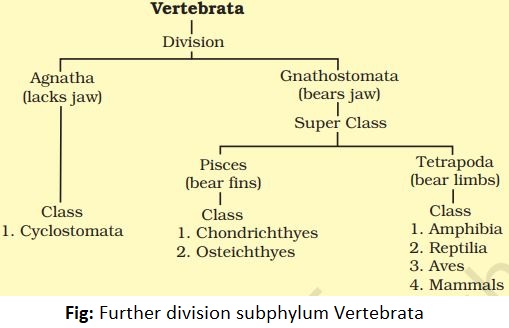
23
Answer
Cyclostomata
- Have sucking and circular mouth without jaws.
- Live as ectoparasites on some fishes.
- Devoid of scales, no paired fins.
- Cranium and vertebral column is cartilaginous.
- Marine habit but migrates to fresh water for spawning and die after spawning.
- Larva returns to ocean after metamorphosis.
- Example, Petromyzon (Lamprey) and Myxine (Hagfish).
- Division Gnathostomata (Bear Jaws)
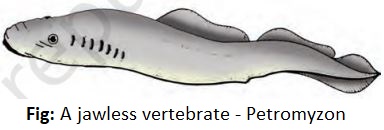
Class 1- Chondrichthyes: Marine animals with stream lined body and have cartilaginous endoskeleton.
- Mouth ventrally located.
- Notochord persists throughout life.
- Gill slits are separate and without operculum.
- Skin has placoid scales.
- Jaw contains teeth, which are modified placoid scales.
- Mostly predaceous.
- Swim bladder absent.
- Heart is two chambered. (One auricle and one ventricle)
- Some of them contain electric organs (Example Torpedo)
- Some possesses poison sting. (Example Trygon)
- Poikilotherm or cold blooded.
- Sexually dimorphic, male’s pelvic fin bears claspers.
- Fertilization internal.
- Many of them viviparous.
- Examples: Torpedo (Electric ray), Rhinobatus (Guitar fish).
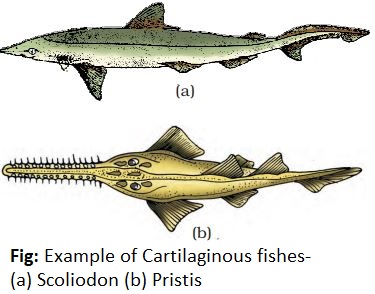
Class 2- Osteichthyes: Includes both marine and fresh water fishes.
- Bony endoskeleton.
- Mouth is usually terminal.
- Four pairs of gill slits covered by operculum.
- Skin has cycloid/ctenoid scales.
- Air bladder is present for buoyancy.
- Heart is two chambered.
- Cold blooded animals.
- Sexually monomorphic.
- Fertilization external.
- Mostly oviparous
- Development is indirect.
- Examples: Marine – Exocoetus (Flying fish), Hippocampus (Sea horse).
- Freshwater – Labeo (Rohu).
- Catla (Katla), Clarias (Magur).
- Aquarium – Betta (Fighting fish), Pterophyllum (Angel fish).
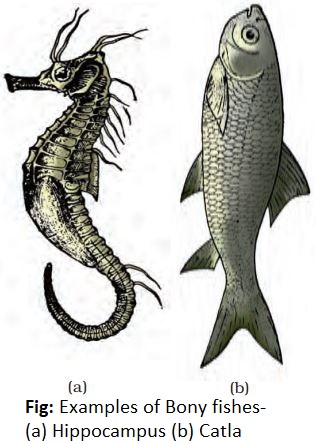
24
Answer
Class 1- Amphibia: It is a class of terrestrial tetrapods which lead a dual life in water as well as on moist land as the skin is devoid of protective scales and the larval stage is aquatic.
The animal possesses two pairs of jointed pentadactyl limb. Their digits do not possess claws, nails, or hoofs.
- Body divisible into head and trunk.
- Skin moist, without scales.
- Tympanum represents ear.
- Cloaca is the common chamber where alimentary, urinary and reproductive tracts open.
- Respiration by gills, lungs or skin.
- Heart is 3-chambered (two auricle and one ventricle)
- Cold blooded animals.
- Sexes separate.
- Fertilization is external and requires water.
- Oviparous, Indirect development.
- Examples: Ichthyophis, Necturus, Siren, Amphiuma, Salamandra, Rana, Bufo, Hyla etc.
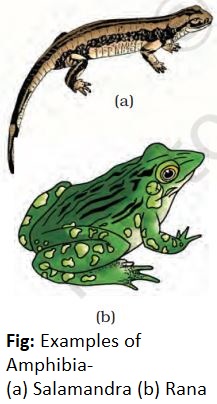
Class 2- Reptilia: Creeping or crawling mode of locomotion.
- Body has dry and cornified skin and epidermal scales or scutes.
- Tympanum represents ear.
- Limbs when present are two pairs.
- Mostly three chambered heart but 4-chambered in crocodiles.
- Snakes and lizards shed scales as skin cast.
- Sexes are separate.
- Fertilization is internal.
- Oviparous, Direct development.
- Examples: Chelone (Turtle), Testudo (Tortoise), Chameleon (Tree lizard), Calotes (Garden lizard),
- Crocodilus (Crocodile), Alligator (Alligator), Hemidactylus (Wall lizard), Poisonous Snakes – Naja (Cobra), Bangarus (Krait), Vipera (Viper).
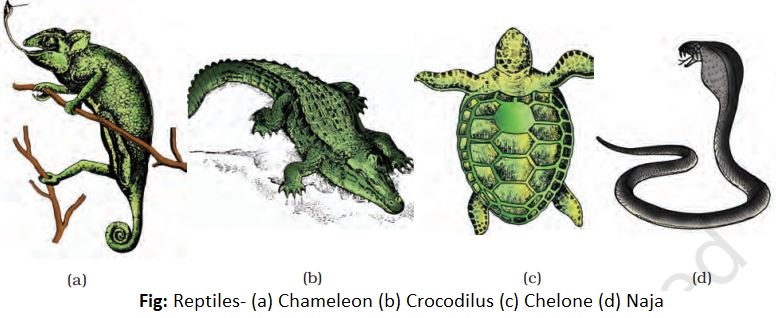
Class 3- Aves: Presence of feathers and most of them fly except flightless bird like ostrich.
- Jaw modified to beak without teeth.
- Forelimbs are modified into wings.
- Hind limbs have scales.
- No glands on skin except oil gland at base of tail.
- Endoskeleton is almost completely ossified.
- Bones are spongy or pneumatic.
- Long bones are hollow with air cavities.
- Epiphyses are absent.
- Skull is monocondylic.
- Digestive tract has additional chambers like crop and gizzard.
- Heart is four chambered.
- Homoiothermous or warm blooded, able to maintain constant temperature.
- Air sacs are connected to lungs to supplement respiration.
- Direct development.
- Examples: Pigeon, Crow, Sparrow, Pea cock etc.
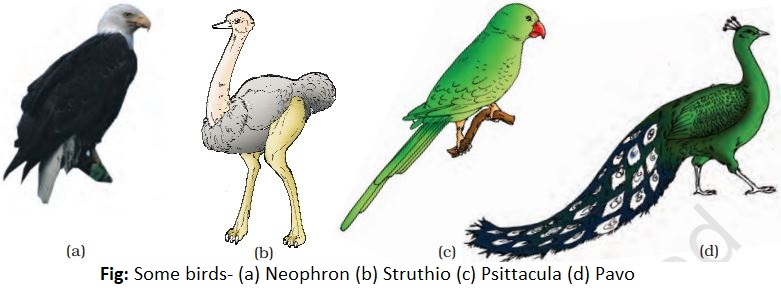
Class 4- Mammalia: Have mammary glands to nourish young ones by secreting milk.
- Have two pairs of limbs.
- Skin has hairs.
- External ears or pinna present.
- Different types of teeth in jaw.
- Heart is four chambered.
- Respiration by lungs.
- Sexes separate, fertilization internal.
- Viviparous or oviparous.
- Direct development.
- Examples: Oviparous-Ornithorhynchus (Platypus).
- Viviparous - Macropus (Kangaroo), Pteropus (Flying fox), Camelus (Camel), Macaca (Monkey), Rattus (Rat), Canis (Dog), Felis (Cat), Elephas (Elephant), Equus (Horse), Delphinus (Common dolphin), Balaenoptera (Blue whale), Panthera tigris (Tiger), Panthera leo (Lion).
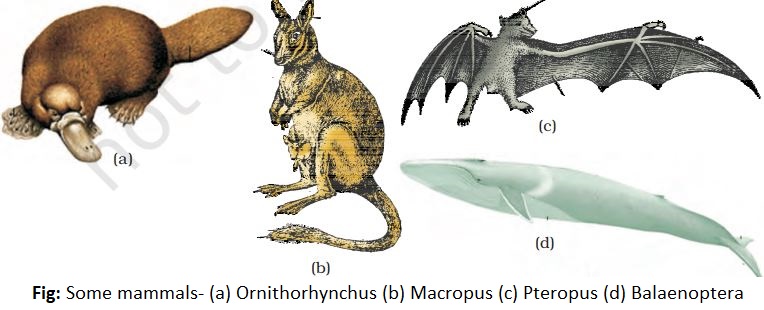
25
Answer
1. Salient Features of Different Phyla in the Animal Kingdom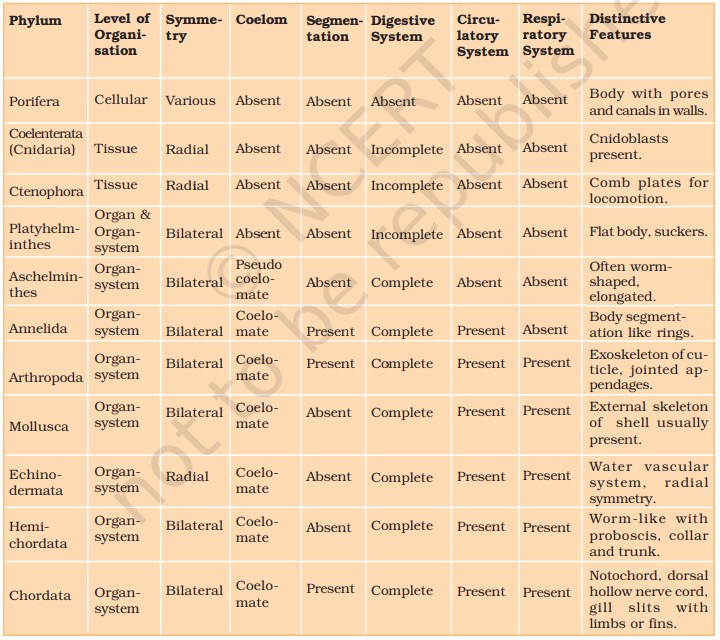
2. Animals are multicellular, heterotrophic, eukaryotes that exhibit different patterns of organisation of several types of cells.
Levels of Structural organisation:
- Cellular level
- Tissue level
- Organ level
- Organ system level
3. On the basis of symmetry, animals can be asymmetrical or symmetrical.
4. Animals can be diploblastic
5. Coelom is the body cavity, which is lined by mesoderm. Classification is also based on the presence or absence of coelom as given below:
- Coelomates
- Pseudocoelomates
6. Kingdom Animalia is classified on the basis of the presence or absence of vertebral column into
- Invertebrate
- Vertebrate
7. During embryonic development, mesodermal cells form a rod like structure on the dorsal surface called notochord. Animals with notochord are known as chordates and without notochord are known as non-chordates.
8. The non-chordates includes
- Phylum Porifera
- Phylum Cnidaria
- Phylum Ctenophora
- Phylum Platyhelminthes
- Phylum Aschelminthes
- Phylum Annelida
- Phylum Arthropoda
- Phylum Mollusca
- Phylum Echinodermata
- Phylum Hemichordata
- Phylum Chordata
9. Phylum Chordata are divided into the following subphyla:
- Urochrodata
- Cephalochordata
- Vertebrata